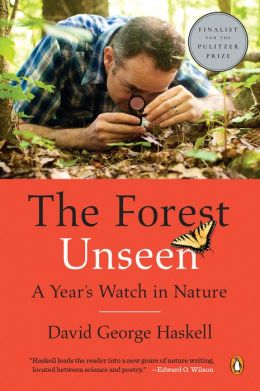Be sure to “Like” greenmomster on Facebook to get all the latest news!
The Forest Unseen by David George Haskell is a book that I truly enjoyed. Dr. Haskell, a professor of biology at the University of the South, watched a small area of woods in Tennessee for an entire year and reports on the experience in this book. Rather than taking a scientific, analytical approach to his
“This book is a biologist’s response to the challenge of the Tibetan mandala, of Blake’s poems, of Lady Julian’s hazelnut. Can the whole forest be seen through a small contemplative window of leaves, rocks, and water? I have tried to find the answer to this question, or the start of an answer in a mandala made of old-growth forest in the hills of Tennessee. The forest mandala is a circle a little over a meter across, the same size as the mandala that was created and swept away by the monks. I chose the mandala’s location by walking haphazardly through the forest and stopping when I found a suitable rock on which to sit. The area in front of the rock became the mandala, a place that I had never seen before, its promise mostly hidden by winter’s austere garb.”
I looked forward to reading this book each evening, wondering what new insights Dr. Haskell might have found in his daily mandala observations. An expert naturalist, Dr. Haskell uses the mandala as a springboard for writing on topics as diverse as salamanders, snails, wind, katydids, fireflies,and fungi. But what really sets this book apart is the writing. Dr. Haskell is an award-winning poet, and this book is beautifully written. I found myself underlining sentences and dog-earing pages, just to be able to refer back to his colorful descriptions of the fascinating world of nature (chloroplasts as “jewel boxes”). Here’s how he describes the experience of viewing the mandala through a small magnifying glass:
“From my prone position I see the snail pause amid lichen flakes and black fungus spiking from the surface of oak leaves. I peek over the lens and suddenly all is gone. The change of scale is a wrench into a different world; the fungus is invisible,the snail is a valueless detail in a world dominated by bigger things. I return to the lens world and re-discover the vivid tentacles, the snail’s black-and-silver grace. The hand lens helps me harvest the world’s beauty, throwing my eyes wide open. Layers of delight are hidden by the limitation s of everyday human vision.”
Dr. Haskell’s writing allows the reader to see many common creatures in a new way. Although I was familiar with many of the organisms and processes he describes in the book, his colorful writing allowed me to see them through a new lens. I learned interesting, new facts on almost every page. For example, if you’ve ever seen a chickadee at a bird feeder, you know it’s a cute little bird. That’s what we see when we’re looking at them, but what do they see?
“Chickadee eyes also perceive more colors than mine can. I view the mandala with eyes that are equipped with three types of color receptor, giving me three primary colors and four main combinations of primary colors. Chickadees have an extra color receptor that detects ultraviolet light. This gives chickadees four primary colors and eleven main combinations, expanding the range of color vision beyond what humans can experience or even imagine. Bird color receptors are also equipped with tinted oil droplets that act as light filters, allowing only a narrow range of colors to stimulate each receptor. This increases the precision of color vision. We lack these filters, so even within the range of light visible to humans. birds are better able to discriminate subtle differences in color. Chickadees live in a hyperrreality of color that is inaccessible to our dull eyes. Here in the mandala, they use these abilities to find food. Ultraviolet light reflects from the dried wild grapes that are sparsely scattered across the forest floor. Wings of beetles and moths are sometimes tinged with ultraviolet, as are some caterpillars. Even without the advantage of ultraviolet vision, insect camouflage is unmasked by slight imperfections detected by the birds’ precise perception of color.”
Dr. Haskell’s beautiful and descriptive writing are what set this book apart. Definitely worth a read – you’ll learn much about the incredible natural world around us!
No comments:
Post a Comment